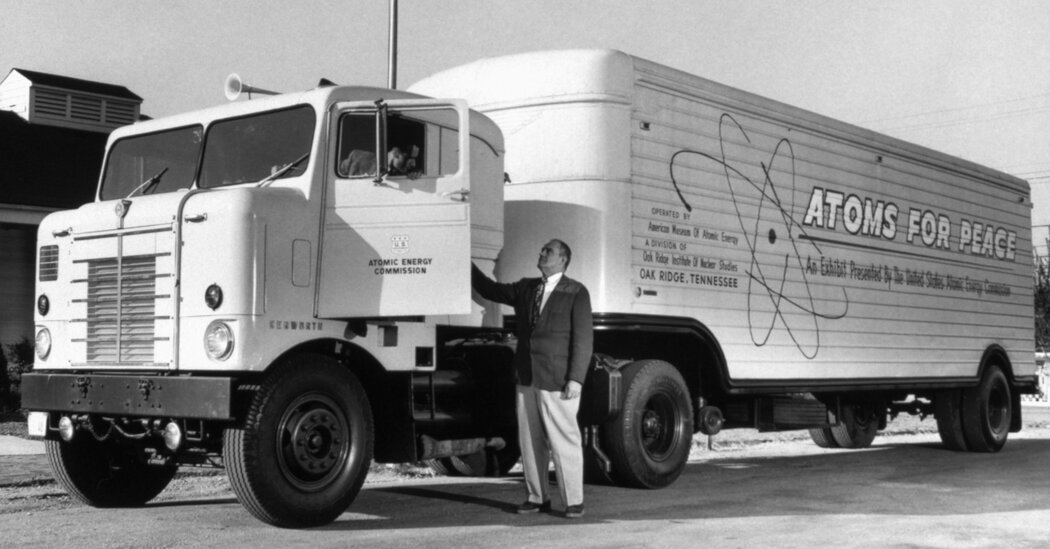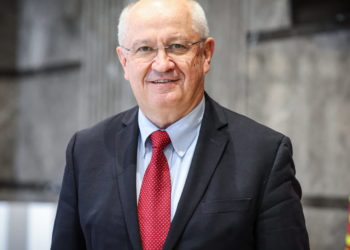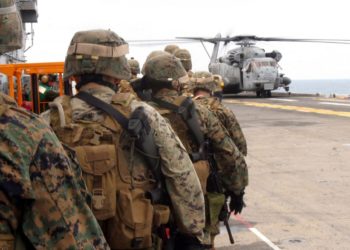When President Trump ordered a military strike on Iran’s nuclear program, he was confronting a crisis that the United States unwittingly set in motion decades ago by providing Tehran with the seeds of nuclear technology.
Tucked into Tehran’s northern suburbs is a small nuclear reactor used for peaceful scientific purposes, which has so far not been a target of Israel’s campaign to eliminate Iran’s nuclear weapons capability.
The Tehran Research Reactor’s real significance is symbolic: It was shipped to Iran by the United States in the 1960s, part of President Dwight D. Eisenhower’s “Atoms for Peace” program that shared nuclear technology with U.S. allies eager to modernize their economies and move closer to Washington in a world divided by the Cold War.
Today, the reactor does not contribute to Iran’s enrichment of uranium, the arduous process that purifies the raw ingredient of nuclear bombs into a state that can sustain a massive chain reaction. It runs on nuclear fuel far too weak to power a bomb. Several other nations, including Pakistan, bear at least as much responsibility for Iran’s march to the threshold of nuclear weapons capability, experts say.
But the Tehran reactor is also a monument to the way America introduced Iran — then governed by a secular, pro-Western monarch — to nuclear technology.
Iran’s nuclear program quickly became an object of national pride, first as an engine of economic growth and later, to the West’s dismay, as a potential source of ultimate military power.
It is a legacy of a dramatically different world, one in which America had yet to grasp how fast the nuclear secrets it unlocked at the end of World War II would pose a threat to the United States.
“We gave Iran its starter kit,” said Robert Einhorn, a former arms control official who worked on U.S. negotiations with Iran to limit its nuclear program.
“We weren’t terribly concerned about nuclear proliferation in those days, so we were pretty promiscuous about transferring nuclear technology,” said Mr. Einhorn, now a senior fellow at the Brookings Institution. “We got other countries started in the nuclear business.”
“Atoms for Peace” was born of a speech Mr. Eisenhower delivered at the United Nations in December 1953, in which he warned of the dangers of a nuclear arms race with the Soviet Union and vowed to lead the world “out of this dark chamber of horrors into the light.”
Mr. Eisenhower explained that the world should better understand such a destructive technology, and that its secrets should be shared and put to constructive use. “It is not enough just to take this weapon out of the hands of the soldiers,” he said. “It must be put into the hands of those who will know how to strip its military casing and adapt it to the arts of peace.”
The gesture was more than altruistic. Many historians argue that Mr. Eisenhower was providing cover for an American nuclear arms buildup already underway. He was also influenced by scientists, including J. Robert Oppenheimer, who had helped to develop the atomic bomb that destroyed Hiroshima and Nagasaki less than a decade earlier. “It was their contrition for participating in the development of the bomb,” Mr. Einhorn said.
The Eisenhower administration also saw the program as a way to gain influence over important pieces on the global Cold War chessboard. They included Israel, Pakistan and Iran, which were given nuclear information, training and equipment to be used for peaceful purposes, such as science, medicine and energy.
The Iran that received an American research reactor in 1967 was very different from the country ruled today by clerics and generals. It was led then by a monarch, or shah, Mohammed Reza Pahlavi, a Swiss-educated aristocrat installed in a 1953 coup backed by the C.I.A., to the lasting anger of many Iranians.
Mr. Pahlavi was determined to modernize his nation and make it a world power, with American backing. He liberalized Iranian society, promoting secularism and Western education even as he harshly repressed political opposition. He banned the woman’s veil and promoted modern art — Andy Warhol once painted his portrait — while investing in literacy and infrastructure.
Kick-started by “Atoms for Peace,” Mr. Pahlavi budgeted billions of dollars for an Iranian nuclear program that he saw as a guarantee of his country’s energy independence, despite its existing vast oil production, and a source of national pride. The United States welcomed young Iranian scientists to special nuclear training courses at the Massachusetts Institute of Technology.
Expanding its program in the 1970s, Iran struck deals with its European allies. During a visit to Paris in 1974, Mr. Pahlavi was celebrated at Versailles before signing a billion-dollar agreement to purchase five 1,000-megawatt nuclear reactors from France.
At first, the shah was a poster boy for the peaceful use of nuclear power. A group of New England utility companies put out full-page ads featuring an image of the shah, who was then widely admired in the United States. Mr. Pahlavi “wouldn’t build the plants now if he doubted their safety,” the ad said. “He’d wait. As many Americans want to do.”
But although the United States had persuaded Iran to sign the 1968 Nuclear Nonproliferation Treaty, in which the country accepted international safeguards and officials forswore nuclear weapons, suspicions about Mr. Pahlavi’s intentions were growing in Washington. A New York Times article in 1974 noted that Iran’s reactor deal with France made “no public mention of safeguards against using the reactors as a base for making nuclear weapons.”
Soon the shah was talking about Iran’s “right” to produce nuclear fuel at home, a capability that can also be applied to nuclear weapons development. He denounced discussions about outside limits on Iran’s nuclear activity as a violation of national sovereignty — talking points still used by Iran’s leadership. As Washington expressed greater concern, Mr. Pahlavi turned to a wider range of nations for nuclear assistance: Germany would build more reactors, and South Africa would supply raw uranium, or “yellowcake.”
By 1978, the Carter administration was alarmed enough to insist that an Iranian contract to purchase eight American reactors be amended. The new version would prohibit Iran from reprocessing without permission any U.S.-supplied fuel for its nuclear reactors into a form that could be used for nuclear weapons.
The American reactors were never delivered. In 1979, the Islamic Revolution, fueled in part by hatred of America and its support for the shah, swept across Iran and deposed Mr. Pahlavi.
For a time, the problem of Iran’s nuclear ambitions seemed to have solved itself. Iran’s new clerical rulers, led by Ayatollah Ruhollah Khomeini, initially showed little interest in continuing an expensive project associated with the shah and Western powers.
But after a brutal eight-year war with Iraq in the 1980s, Ayatollah Khomeini reconsidered the value of nuclear technology. This time, Iran turned east — to Pakistan, another “Atoms for Peace” beneficiary that was by then within a decade of testing a nuclear bomb. The Pakistani scientist and nuclear black marketeer Abdul Qadeer Khan sold Iran centrifuges to enrich uranium to bomb-grade levels of purity.
Iran’s acquisition of centrifuges was the real reason its nuclear program escalated into a global crisis, said Gary Samore, the top White House nuclear official in the Clinton and Obama administrations.
“Iran’s enrichment program is not the result of U.S. assistance,” Mr. Samore said. “The Iranians got their centrifuge technology from Pakistan, and they have developed their centrifuges based on that Pakistani technology — which itself was based on European designs.”
But those centrifuges were put to use by an Iranian nuclear establishment created by America decades earlier.
For years, Iran secretly advanced its nuclear program, building more centrifuges and enriching uranium that could one day be fashioned into a bomb. After Iran’s secret nuclear facilities were exposed in 2002, the U.S. and its European allies demanded that the country stop its enrichment and come clean about its nuclear activities.
After more than 20 years of diplomacy — and now airstrikes by Israel and the United States — the confrontation remains unresolved. Despite Mr. Trump’s initial claims that Saturday’s bombing raid “totally obliterated” three Iranian nuclear sites, portions remain intact.
The United States can still learn from its painful experience, Mr. Samore said. The Trump administration has continued negotiations, begun under President Joseph R. Biden Jr., for the potential transfer of U.S. nuclear technology to Saudi Arabia — another Middle East ally ruled by a strongman with grand ambitions for modernizing his nation.
It has been U.S. policy for decades not to share the know-how to produce nuclear fuel — which can also be used to make bombs — with countries that do not already have it, Mr. Samore noted. “And we’ve gone out of our way to block allies, including South Korea, from acquiring fuel enrichment and reprocessing capabilities,” he said.
The Saudis are ostensibly seeking the ability to enrich uranium for nuclear power.
“But this kind of technology can also be used for nuclear weapons,” Mr. Samore added. “And from my standpoint, it would be a terrible precedent to help a country like Saudi Arabia, or any country that doesn’t have that capability.”
Michael Crowley covers the State Department and U.S. foreign policy for The Times. He has reported from nearly three dozen countries and often travels with the secretary of state.
The post How the United States Helped Create Iran’s Nuclear Program appeared first on New York Times.




